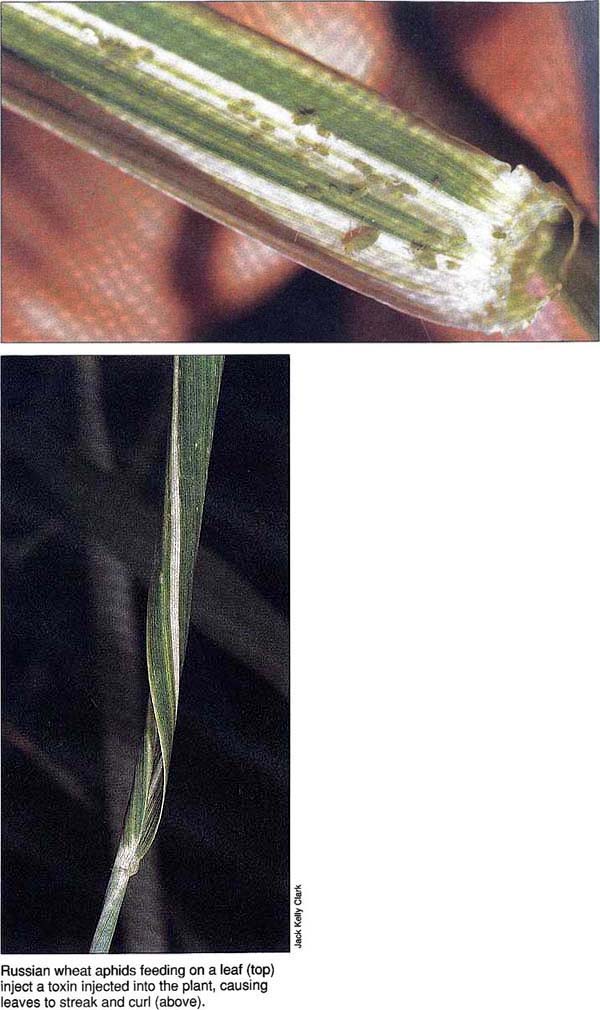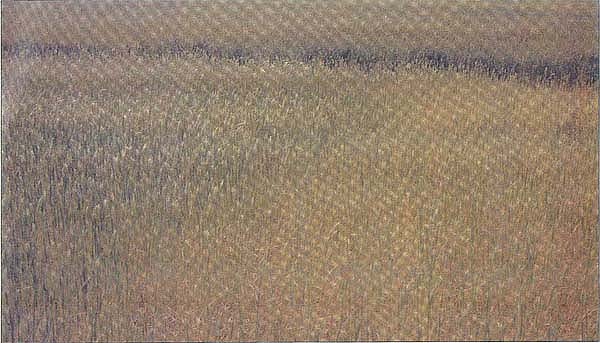All Issues
Controlling Russian wheat aphid in California
Publication Information
California Agriculture 45(1):6-8.
Published January 01, 1991
PDF | Citation | Permissions
Abstract
The Russian wheat aphid is spreading rapidly through California. The pest injects a powerful, growth-inhibiting toxin into grain plants. Without insecticide treatment, crop losses can be severe.
Full text
Russian wheat aphids feeding on a leaf (top) inject a toxin injected into the plant, causing leaves to streak and curl (above).
The Russian wheat aphid (RWA), Diuraphis noxia(Mordvilko), was first discovered in the United States near Lubbock, Texas, in 1986. It has now spread to all states from Texas to North Dakota and westward to the Pacific Ocean. It can also be found in central and western Canada. RWA was found in 1988 in Imperial County, California, and has now spread to most grain production areas of the state. No important biological control agents are currently being used to suppress RWA.
Russian wheat aphid is a serious pest of wheat, barley, triticale, and rye. Most reports from the Midwest and from our own field trials indicate that oats is a poor host for RWA. Several species of native and introduced grasses (Bermuda grass, ripgut brome, rescue grass, and foxtail barley) will support RWA populations. Besides cultivated cereal grains, several species of range grasses may be attacked.
Small grains constitute a substantial acreage in California. In 1989, wheat and barley totaled 1.5 million acres with a value of $255 million. Oats and barley grown for hay constitute additional acreage and dollar value. Economic losses attributable to RWA can be categorized as reduced yields, loss of kernel weight and quality, livestock grazing losses, and increased costs for purchase and application of insecticides.
This barley hay field at Lucerne Valley, California, was treated with 8 oz (active ingredient) dimethoate per acre to control Russian wheat aphid. The plots at right were not treated.
We cannot project cost increases and future grain crop losses for California. However, reports of crop losses and insecticide control costs from states where RWA has been present through two or three growing seasons indicate a devastating impact. In 1987, the estimated RWA-induced crop losses in 10 Great Plains states totaled $53.8 million. In Texas alone, the total loss for 1988 was nearly $100 million, with a $140 million loss projected for 1989. To make matters worse, crop losses from RWA increase under drought conditions that stress the plants. Such conditions could markedly affect dryland grain growers in California.
Control of RWA in some areas of the Midwest requires two or three insecticide applications per season. We believe this frequency of treatment is due in part to a lack of information on the economic threshold levels and the proper timing of treatment. In a marginally profitable crop (compared to tree, vine, and vegetable crops), such expenses cannot be tolerated. The loss of wheat or barley as a viable crop would also affect crop rotation programs used in California's field crop production.
RWA is now established over a large portion of California. It will eventually spread to all grain production areas of the state. Most infestations during 1989 were relatively light and did not cause damage until the grain was in the latter half of the growth season, so 1989 crop losses and treatment costs were minimal. The 1989-1990 winter growing season was much different. Indeed, infestations were found in the Mojave Desert on seedling barley in mid-December. Without insecticide applications, these infestations could have caused severe crop losses.
Current research
University of California scientists are working to obtain biological and ecological data on RWA with which to develop pest management strategies. Current research includes establishment of a statewide network of suction traps to evaluate flight behavior and seasonal activity and to serve as a detection tool; biological control, including an evaluation of native predators and parasites and a search for new parasites to introduce; biology, ecology of RWA, and analysis of alternate hosts during the hot dry season; and development of easy methods of field sampling with which to establish an economic threshold for insecticide treatment. We believe we can develop a ratio of infested to non-infested plants that can be used in conjunction with plant growth to determine an economic treatment level.
In 1982, agricultural researchers in South Africa found that the mechanism for plant injury from their new grain pest (RWA) was a powerful toxin injected by the pest into the host plant. Among the toxin's effects is the destruction of chlorophyll, which severely inhibits the plant's ability to produce carbohydrates. Chlorophyll loss gives the leaves and stems a whitish, bleached appearance. Leaves may curl so tightly they resemble soda straws, and infested plants are severely stunted.
Heavily infested plants often appear flattened, with the young tillers lying almost parallel with the ground. If attacked when young, plants may be killed. Although unconfirmed, RWA may be a vector for several important virus diseases of small grains, including barley yellow dwarf virus.
The two actions of RWA — feeding and toxin injection — cause a significant reduction in both root and tiller biomass. Tiller development and leaf initiation are delayed, and significant differences occur in growth rate within one week after aphid infestation. Infected plants are easily pulled from the soil.
Field trials
In the spring of 1989, we began to evaluate the effectiveness and timing of insecticides for RWA control. Aphid populations in nearly all grain fields included Russian wheat aphid (Diuraphis noxia), the greenbug (Schizaphis graminum), and the oat bird-cherry aphid (Rhopalosiphum padi). Of these three, RWA is most destructive, the green-bug next, and the oat bird-cherry aphid least destructive.
Trial I.
On April 19, we applied dimethoate (Cygon) to barley hay at a per-acre rate of 8 oz active ingredient (ai) in 25 gallons of water (table 1). There were four treated replicates and four untreated replicates. All replicates were 20 feet wide and 54 feet long. There were on average 42 grain tillers per square foot in the plot area, and the barley showed signs of severe tiller damage.
Aphid samples were taken with a suction sampler equipped with a 1-square-foot nozzle cone. Initial aphid control for each of the three species was about 96 , as compared to the untreated plots.
By May 10,21 days after treatment, aphid populations had decreased markedly in the untreated plots. By this time, the grain had started to turn yellow and begun to dry. Using a Carter Forage Plot Harvester, we harvested the chopped barley in a 2.8- by 54-foot strip in the center of each replicate and measured its net weight. We immediately put a subsample of the chopped barley from each replicate into a plastic bag. Each of these subsamples was later spread over a sheet of paper and dried to brittleness. The dry weights were recorded and adjusted to the 14 moisture content of field-baled barley hay, and calculated to pounds per acre for all treatments.
Grain hay growers in irrigated areas expect yields of 3 tons or more per acre. Our barley hay field had been severely damaged by RWA before treatment. In our measurements, the treated area yielded 1.47 tons per acre, and the untreated area yielded 0.85 ton per acre. Even though dimethoate gave about 96 control of the three aphid species, the degree of injury to plants before treatment was sufficient to inhibit recovery.
Trial II.
We applied four insecticides in separate treatments May 16 to a barley hay crop near Lancaster, California. Most con-trolled RWA well(table 2).RWA populations in the untreated check peaked at 332 aphids per square foot on May 19. When we measured barley hay yields on May 30, we found no significant difference between any of the treatments. Had we applied the treatments further in advance of crop maturity, we probably would have seen greater differences.
TABLE 1. Control of various aphids in barley hay and effect on yield, Lucerne Valley, San Bernardino County, California, 1989
TABLE 3. Control of various aphids In barley hay and effect on hay and grain yield, Lancaster, California, 1989
We took additional samples to measure grain yields on June 8. For these samples, we found significant differences in yield between treatments. Grain yields tended to decrease in relation to the degree of RWA control for the insecticide and dosage used. The data suggest that when a cereal is being grown for grain, the aphids must be controlled earlier and for a longer time than when the crop is being grown for hay.
Trial III.
For the third trial, we applied 0.25 pound dimethoate per acre on April 19. This barley hay field began with far fewer RWAs than did the fields in trials I and II. The untreated plots reached a peak of 144 RWAs per square foot on May 17 (table 3).
Crop yields taken on May 26 showed 3.1 tons of barley hay per acre for the treated plots. The untreated plots gave 2.3 tons per acre. There were 1,403 pounds of barley grain per acre in the treated plots and 1,049 pounds of grain in the check plots.
Trial IV.
Researchers in the Midwest have cited oats as a poor host for RWA. Our fourth trial was set in an oat hay field 20 feet from a barley field where, essentially, all of the plants were infested with RWA. Dimethoate was applied April 19 at a rate of 0.25 pounds ai per acre (table 4). RWA populations remained low in the oat hay field through April and May. We measured yields on June 3, and found no significant difference in yields of treated and untreated plots. The barley field 20 feet away showed dear signs of abundant honeydew and black sooty mold on all grain plants. Our results confirm that RWA does little or no damage to oats.
Conclusions
Russian wheat aphid is a devastating pest of cereal grains. Our field trials show that severe crop losses can occur if a high population of RWA is present, and no chemical treatment is applied. Preliminary data on irrigated wheat or barley indicate treatment to such fields should be applied when 20 to 25 of the tillers show typical RWA symptoms and 70 of the tillers have not reached the first-node stage. As yet, no dependable biological control agent is available to suppress this new invader.










